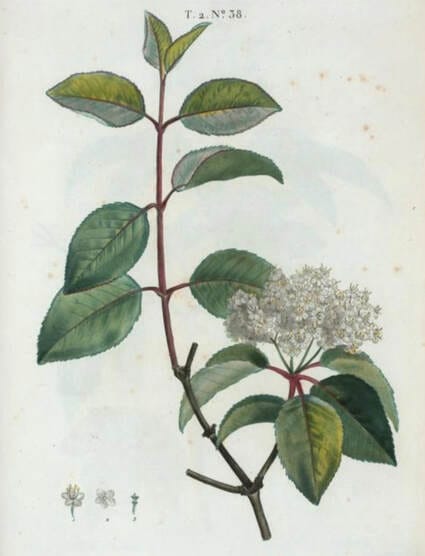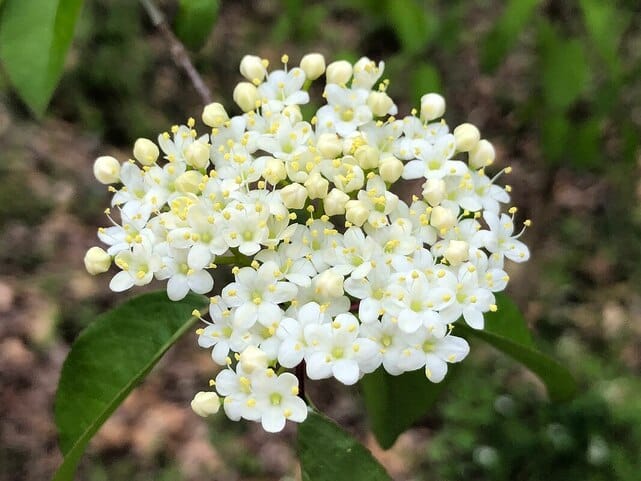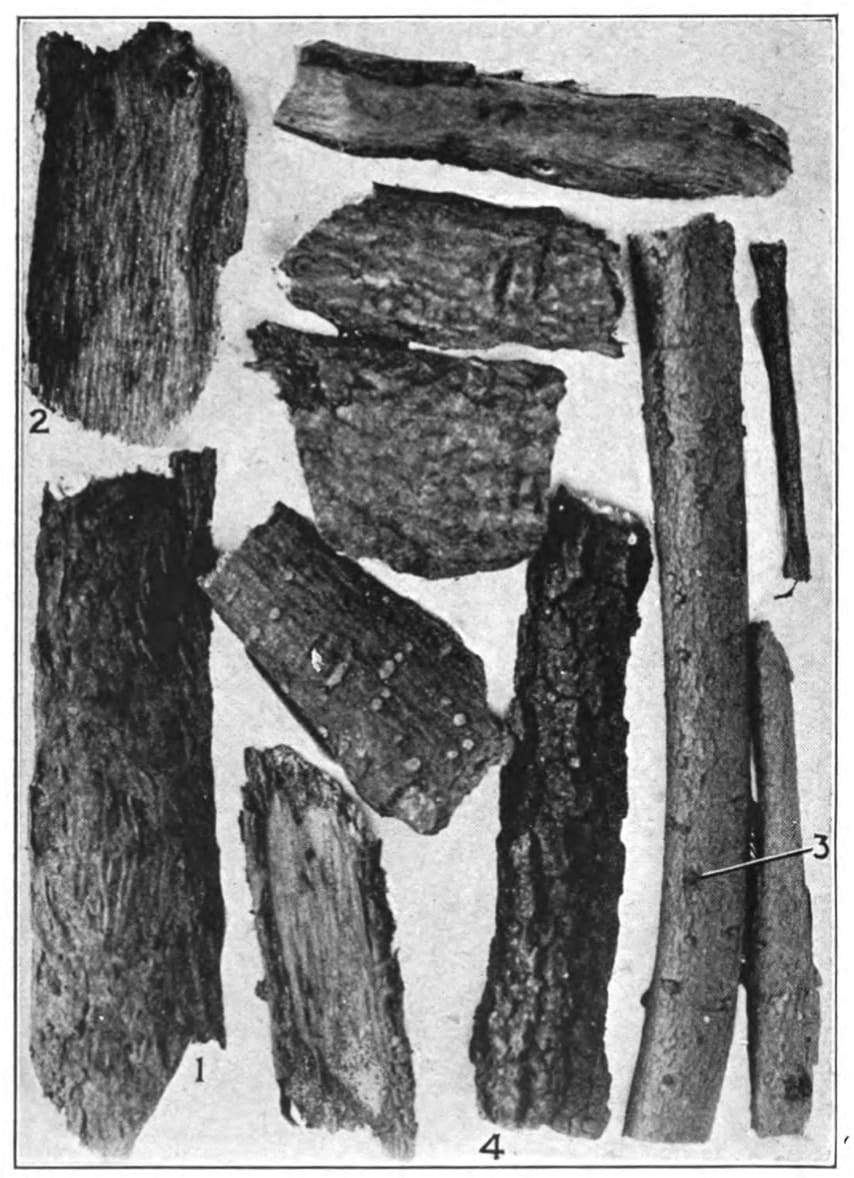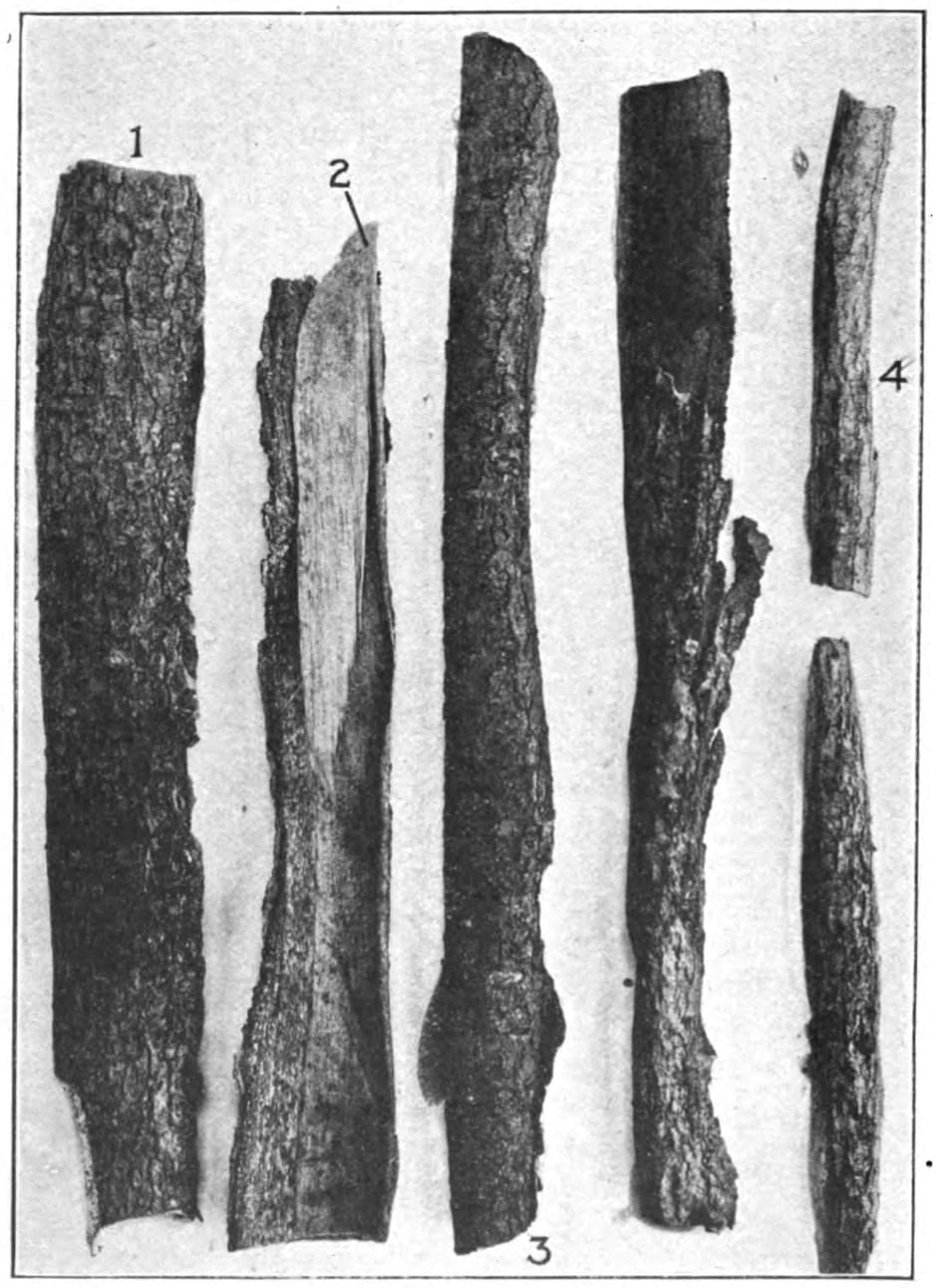Viburnum, Cramp-bark
Black Haw, Wild Guelder Rose Viburnum prunifolium
Viburnum prunifolium(Illustration by Pierre-Joseph Redouté) (Wikimedia)
 Viburnum prunifolium flowers
Viburnum prunifolium flowers(Photo by Famartin) (Wikimedia)
 Viburnum prunifolium bark
Viburnum prunifolium bark |
 Viburnum opulus bark
Viburnum opulus bark |
Botanical name:
Viburnum spp.
- V. opulus–Cramp Bark, High Cranberry, Wild Guelder Rose
- V. prunifolium–Black Haw
Parts used:
Bark
Temperature & Taste:
Warm, dry. Bitter, Pungent
Classification:
Uses:
1. Moves the Blood, Regulates Menstruation:
-Amenorrhea, Dysmenorrhea (especially with spasmodic pain and cramping)
-Irregular Menstruation, Metrorrhagia
-Helps prepare for Birth, promotes easier Labor (from 2 weeks before due date)
-also for Threatened or Habitual Miscarriage (V. prunifolium is strongest)
-PMS
-Infertility
2. Settles Wind, Stops Spasms:
-Cramps, Spasms, Convulsions, Lockjaw
-Hysteria, Nervous disorders, Anxiety and Nervous Tension
-Spasmodic Asthma
-Rheumatism
3. Clears Damp, Promotes Urine:
-Edema, obstructed Urine
4. Moves the Blood, Resolves Masses:
-used for Cancer, the decoction taken freely (Rafinesque, Medical Flora, 1828)
5. Externally:
-topically to Pain, Neuralgia, Cramping
Dose:
The following doses are for Viburnum prunifolium. V. opulus is regarded as stronger and is given in half the dose by some sources, but is given in the same doses by others..
Powdered Bark: 1–3 grams (up to 5 grams)
Decoction: 1 tablespoon per cup, or half oz. to a Pint, given in Tablespoonful doses (Grieves)
Decoction (V. opulus): steep 2 oz. in 1 quart of hot water, press and boil to half a pint. Dose: 1 fluid ounce.
Tincture: 2–5 mls., up to 2 teaspoonfuls (10 mls), three times daily
Fluid Extract of Viburnum prunifolium: 3–6 mls.
Comment:
1. Grieves said of V. opulus: “Its constituents are identical with the species of Viburnum that is more widely used and is an official drug in the United States, viz. Viburnum Prunifolium or Black Haw, though Cramp Bark contains 1/3 the resin contained in Black Haw and its similar properties are considered much weaker.”
2. The leaf was used as a tea, and the bark was smoked by indigenous Americans. The fruits have been eaten and are similar to Cranberry.
Main Combinations:
1. Dysmenorrhea:
i. Viburnum prunifolium, Black Cohosh
ii. Viburnum and Pulsatilla
iii. spasmodic Dysmenorrhea, Viburnum with Cannabis
2. Dysmenorrhea with Endometriosis, Viburnum prunifolium, Black Cohosh, Dioscorea villosa
3. PMS, Viburnum with Agnus Castus, Valerian, Balm
4. Promote easier Labor, 2 weeks before the due date take 5 drops of the tincture (V. opulus), 3 times per day. It is said to give easier labor without afterpains. (The medical genius, Jones, 1887)
5. Threatened Miscarriage:
i. Viburnum prunifolium, Black Cohosh
ii. “Viburnum prunifohum, (fluid extract) take 1 drachm every hour until the pains are assuaged, and afterward as a guard, ½ drachm, once or twice a day, as long as seems needful”. (The medical genius, Jones, 1887)
6. Postpartum tonic:
i. Viburnum with Motherwort
ii. with injury and tearing, Viburnum with Comfrey
7. Asthma and Nervous Restlessness, Viburnum with Blue Cohosh (Cook)
8. Anxiety, Viburnum with Valerian
9. Nervous Headache, Viburnum with Betony, Valerian
10. Nervous Heart complaints, Viburnum, Motherwort, Linden, Yarrow
11. Diverticulitis, Viburnum, Wild Yam, Valerian, Peppermint (Hoffman)
12. Gravel, Stones: Viburnum, Queen of the Meadow, Corn Silk, Collinsonia
13. Facial or Trigeminal Neuralgia, Viburnum opulus, Gelsemium, Belladonna tinctures (equal parts), moisten a cotton ball and place in the ear on the same side as the neuralgia, or in both sides if necessary. (The Medical Genius, Jones, 1887)
Major Formulas:
Cautions:
Generally regarded as safe.
1. It is high in oxalates so should not be used in those with Kidney Stones.
2. Large doses cause Nausea and Vomiting.
